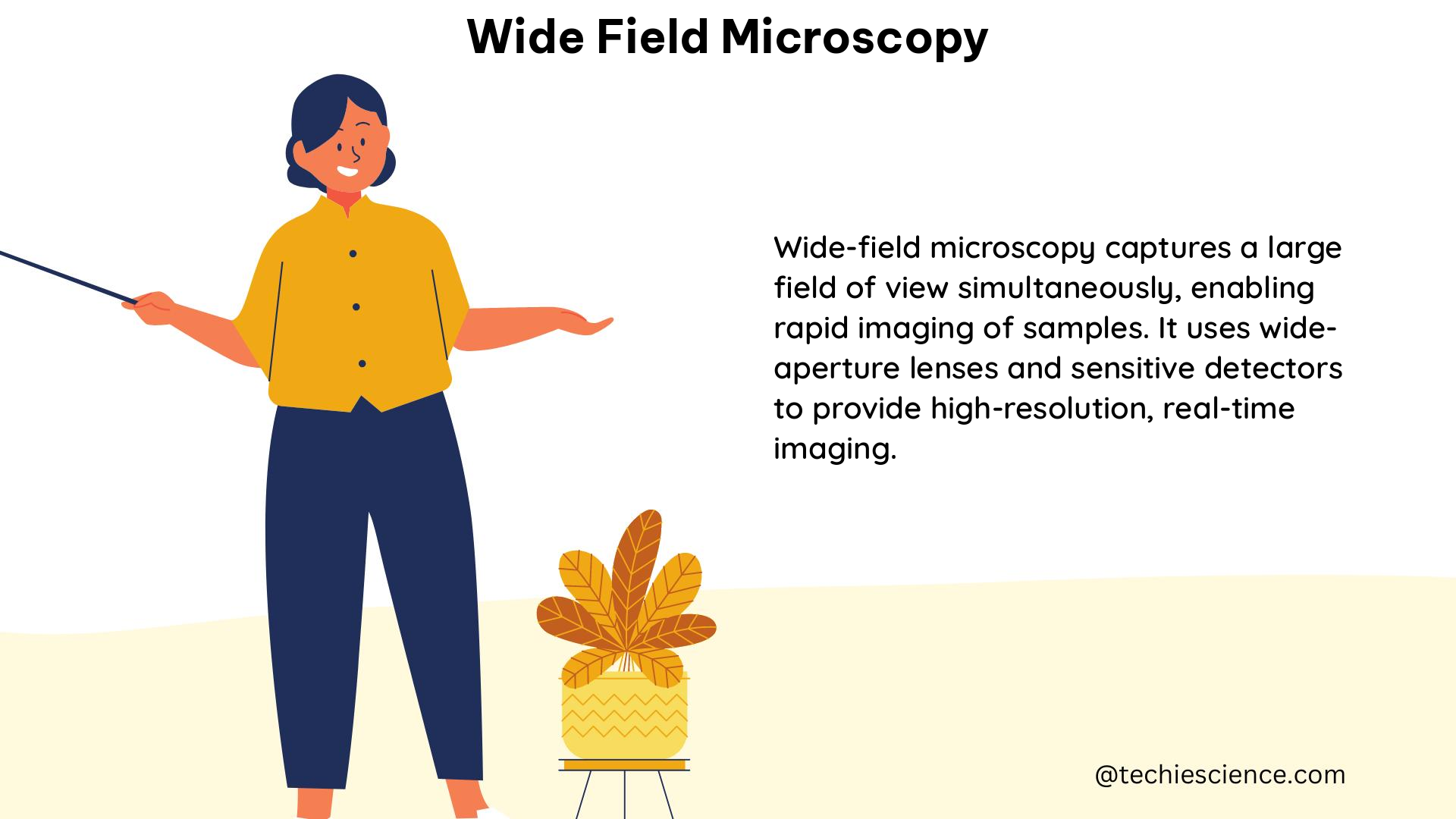Wide field microscopy is a powerful imaging technique that offers high sensitivity and a large field of view, making it a valuable tool in various scientific and medical applications. This comprehensive guide will delve into the technical details, principles, and practical aspects of wide field microscopy, providing physics students with a thorough understanding of this advanced imaging modality.
Understanding the Fundamentals of Wide Field Microscopy
Wide field microscopy, also known as epifluorescence microscopy, is a technique that illuminates the entire sample simultaneously, capturing a large field of view. This approach differs from confocal laser-scanning microscopy, where the sample is scanned point-by-point, and out-of-focus light is rejected through a pinhole.
The key components of a wide field microscope include:
- Illumination Source: Typically, a mercury or xenon arc lamp is used to provide a broad spectrum of excitation light.
- Excitation and Emission Filters: Bandpass filters are used to select the appropriate excitation and emission wavelengths for the fluorescent probes or dyes used in the sample.
- Objective Lens: High numerical aperture (NA) objective lenses are employed to maximize the collection of emitted fluorescence.
- Charge-Coupled Device (CCD) Camera: A sensitive CCD camera is used to capture the fluorescence images.
The resolution of a wide field fluorescence microscope is typically around 200 nm, which is sufficient for the visualization of cellular organelles, molecular complexes, and even some pathogens. However, this resolution can be further improved through the use of advanced techniques, such as deconvolution and super-resolution microscopy.
Deconvolution: Restoring Blurred Images

Deconvolution is a powerful image processing technique used in wide field microscopy to restore blurred images. This process involves the use of the point spread function (PSF), which describes the blurring of light by the microscope optics.
The PSF can be measured experimentally or calculated based on the microscope’s optical parameters. By applying a deconvolution algorithm to the acquired image, the blurring effect can be reversed, resulting in a sharper and more accurate representation of the sample.
Deconvolution is crucial for quantitative analysis of wide field microscopy images, as it allows for the accurate measurement of fluorescence intensity, object size, and spatial relationships within the sample.
Modeling and Simulations in Wide Field Microscopy
The process of model convolution is an essential tool in wide field microscopy. It involves the use of the known PSF to blur a simulated image, which can then be compared to the experimentally acquired data. This comparison allows researchers to draw conclusions about the geometry and fluorophore distribution within the sample.
Gaussian fitting is another important technique used in wide field microscopy. It forms the basis for point localization microscopy, where the centroid of a fluorescent spot is determined with high precision. This approach can be applied to track the motion of individual molecules or measure the size and shape of fluorescent structures.
Addressing Illumination Stability and Noise in Wide Field Microscopy
Illumination stability is a crucial factor in wide field microscopy. The output of mercury lamps, commonly used as the light source, can fluctuate up to 10% on timescales of milliseconds to seconds, and this variability becomes more pronounced as the lamp ages. Careful monitoring and stabilization of the illumination source are essential to ensure consistent and reliable results.
Another source of variability in wide field microscopy is photon shot noise, which arises from the inherent uncertainty in the detection of photons by the CCD camera. The relative contribution of shot noise decreases with increasing photon counts; therefore, it is essential to collect as many photons as possible without damaging the sample.
Comparing Wide Field and Confocal Microscopy
Wide field microscopes image pixels in a large field of view simultaneously, resulting in high sensitivity but reduced contrast due to significant background from out-of-focus light. In contrast, confocal laser-scanning microscopes (CLSMs) illuminate the sample point-by-point and remove out-of-focus light by passing only the in-focus-emitted fluorescence through a pinhole. This approach improves image contrast but reduces sensitivity compared to wide-field microscopes.
The choice between wide field and confocal microscopy depends on the specific requirements of the experiment, such as the need for high sensitivity, high contrast, or a balance between the two.
Calibration and Quantitative Fluorescence Imaging
Calibration of wide-field deconvolution microscopy is essential for accurate measurement and scaling of intensity values. This process involves the use of reference samples with known fluorophore concentrations or fluorescence intensities to establish a reliable relationship between the measured signal and the actual fluorophore concentration or intensity.
Calibration allows for the quantification of changes in fluorescence that may be indistinguishable to the naked eye, enabling researchers to make precise and reliable measurements of biological processes and phenomena.
Conclusion
Wide field microscopy is a powerful imaging technique that offers high sensitivity and a large field of view, making it a valuable tool in various scientific and medical applications. This comprehensive guide has provided physics students with a detailed understanding of the fundamental principles, technical aspects, and practical considerations of wide field microscopy.
By mastering the concepts and techniques presented in this guide, physics students will be well-equipped to leverage the capabilities of wide field microscopy in their research and contribute to the advancement of scientific knowledge.
References:
- Motic Microscopes. “Introduction to Wide-Field Fluorescence Light Microscopy.” https://moticmicroscopes.com/blogs/articles/introduction-to-wide-field-fluorescence-light-microscopy
- Biophysical Journal. “Quantitative Fluorescence Microscopy: From Basics to Advances.” https://www.ncbi.nlm.nih.gov/pmc/articles/PMC4076117/
- Nature Methods. “Quantitative Fluorescence Microscopy: Concerns and Common Pitfalls.” https://www.ncbi.nlm.nih.gov/pmc/articles/PMC3942261/
- Carpenter-Singh Lab. “Quantifying Microscopy Images: Top 10 Tips for Image Acquisition.” https://carpenter-singh-lab.broadinstitute.org/blog/quantifying-microscopy-images-top-10-tips-for-image-acquisition

The lambdageeks.com Core SME Team is a group of experienced subject matter experts from diverse scientific and technical fields including Physics, Chemistry, Technology,Electronics & Electrical Engineering, Automotive, Mechanical Engineering. Our team collaborates to create high-quality, well-researched articles on a wide range of science and technology topics for the lambdageeks.com website.
All Our Senior SME are having more than 7 Years of experience in the respective fields . They are either Working Industry Professionals or assocaited With different Universities. Refer Our Authors Page to get to know About our Core SMEs.